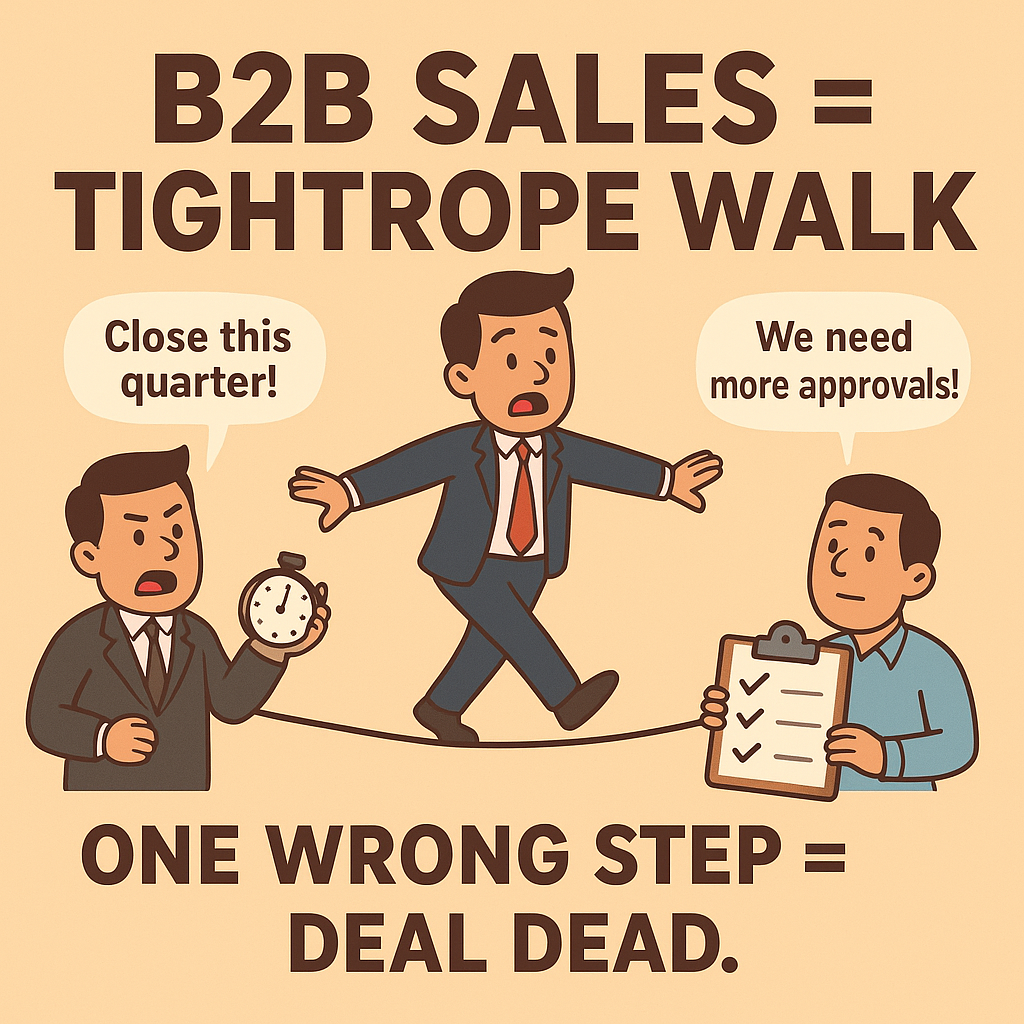The Tightrope of B2B Sales: Keeping Customers Happy While Your Boss Breathes Down Your Neck
Every quarter, countless complex B2B deals collapse—usually because sellers forget one uncomfortable truth: customers don’t care about your quota deadlines. Leadership does. And sellers are stuck in the middle of this tug-of-war.
The best sellers manage both sides brilliantly, like professional jugglers who never drop the ball. The worst? Well, they drop it on their own foot, and both the customer and company pay the price. According to Gartner’s 2019 B2B Buying Survey, a whopping 77% of buyers said their last purchase was “complex” or “very difficult.” Translation: this isn’t amateur hour.
So how do you stop being the seller who panics at the end of every quarter and instead become the one who sails through? Simple—you master timelines, set expectations, and over-communicate.
Step 1: Stop Guessing Timelines (You’re Not a Fortune Teller)
Too many sellers assume they “know” how long a deal will take. Spoiler alert: they don’t. Unless you’ve asked your customer what steps they went through last time, who had to approve, and whether the process has changed, you’re just making it up.
If the customer doesn’t know either? That’s your cue to check whether the pain is real enough for them to figure it out. Otherwise, you’re setting yourself up for the dreaded “slipped deal.”
With omnichannel sales and AI now in the mix, the timing dance is trickier than ever. If marketing’s sending nurture emails, success is pushing webinars, and you’re talking pricing—without syncing—your buyer is more confused than entertained. The best sellers coordinate all of it, and guess what? Those who master this see EBIT growth that makes their peers jealous (McKinsey found 13.5% growth for the pros vs. 1.8% for the rest).
Step 2: Tell Everyone What’s Going On (No, Really, Everyone)
Once you know the internal and external timelines (or at least your best educated guess), share them. Customers need to know what hoops they’ll jump through, and management needs a roadmap instead of vague optimism.
And don’t keep one single “master” timeline. The pros I’ve coached always kept two:
One for customers (what they see).
One for internal management (what’s really happening).
That way, you can tell the customer “it’ll take 2 weeks” while telling your boss “realistically, it’s more like 6 if procurement doesn’t ghost us.” Both sides get what they need, and you look like the adult in the room.
Step 3: Communicate Like Your Job Depends on It (Because It Does)
Silence kills trust. If something changes, tell your customer. If a risk pops up, tell your boss. If you don’t, management will invent their own story—and it usually isn’t flattering.
I’ve seen too many sellers try to “wait it out” and end up blindsided. The smart ones keep both sides in the loop constantly. That way, if a deal stalls or blows up (as they often do), trust carries them through the turbulence.
Here’s the kicker: once you’ve clearly explained the risks and timelines, if management still pushes for unrealistic forecasts, that’s no longer your dilemma. That’s theirs.
The Bottom Line:
To survive complex B2B sales without losing your sanity (or your credibility):
Nail down internal and external timelines early.
Set crystal-clear expectations with customers and management.
Over-communicate until you’re annoying (trust me, it works).
Follow these three rules, and you’ll protect the customer, the quarter, and yourself. Fail to do so, and you’ll spend every quarter-end explaining why your “sure thing” is still “pending approval.”

